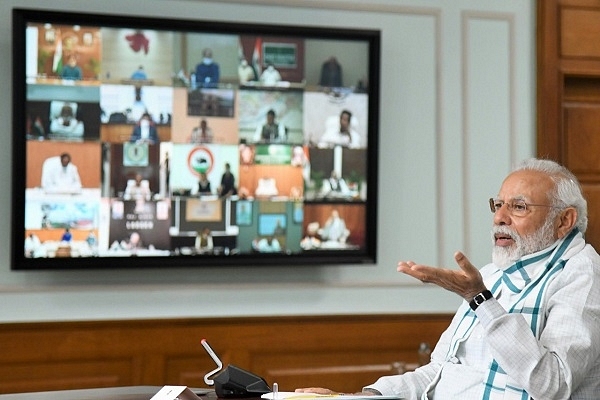Economy
Haryana Down 13 Ranks, UP Improves By 10: Why The Ease Of Doing Business Rankings Saw Drastic Changes This Time
- While Uttar Pradesh and Delhi witnessed drastic improvement, many other states saw big decline in the latest Ease of Doing Business rankings released by the Centre.
- There are two factors which are behind these significant changes.

Prime Minister Modi interacting with Chief Ministers (PIB)
The fourth edition of Ease of Doing Business Rankings by Department of Promotion of Industry And Internal Trade (DPIIT) were released on 5 September. These analysed the business environment of all the states in the financial year 2018-19.
While Andhra Pradesh retained its position as the leader among Indian states, the highlight of the rankings was Uttar Pradesh which jumped 10 spots to become number two.
But the less talked about aspect of the rankings was drastic changes in ranks of some states. UP was not an outlier in improving its standing. Delhi also scaled up its position by 11 spots and came at 12th in the list.
But the problematic part is that many states saw drastic decline in their ranking. Haryana, which came third last time, fell to 16th. Odisha‘s ranking worsened from 14th to 29th, Bihar’s to 26th from 18th earlier, Kerala’s to 28th from 21st, Karnataka’s to 17th from 8th, Gujarat’s to 10 from 5. Among UTs, Lakshadweep‘s position slipped from 15th to 34th and Andaman and Nicobar went down from 22nd to 31st rank.
Fall in rankings of Gujarat, Karnataka and Haryana is particularly concerning as these states are major economic engines of India with great growth potential.
So, what led to such drastic changes in ranks this time?
First, the EoDB rankings are based on Business Reform Action Plan 2019 (BRAP) prepared by the DPIIT and it was somewhat different from the last BRAP of 2017-18. Many new parameters were added and some were deleted.
To just given an example, under the ‘Single Window System’, an additional reform that the States had to implement was to “Ensure 'Allotment of land in Industrial Area' provided as a service through the online single window system facilitating online application submission, payments, tracking of status and approvals”. And a recommendation to “establish the single window agency has been set up through a legislation” was dropped from the earlier BRAP.
Similarly, under the ‘Land availability and allotment’ head, an addition requirement for states was to “Digitize land transaction deeds of last 10 years at all sub-registrar offices and make the same available on an online system to check for ownership details and history.” But earlier suggested reform to “Define clear timelines mandated through the Public Service Delivery Guarantee Act (or equivalent) legislation for processing of application for conversion of land/ change in land use (from the date of application) for land outside of industrial parks/IDCs” was dropped.
In all, 25 new parameters were added across 12 heads while over 97 old parameters were deleted (Full list here and here respectively).
It seems that the States which were proactive and took the changes seriously and implemented them were able to improve their ranks while the ones which lost out didn’t pay much attention to the restructured BRAP.
Second, one of the biggest changes in BRAP 2019 was introduction of feedback score while calculating rankings of the states. This was done “to measure effectiveness of reforms at grass-root level“ and all the States were assessed only on the feedback received from actual users of services, the stakeholders which are supposed to be beneficiaries of these reforms.
So, the government selected industrial estates and other intended beneficiaries of the reforms, sent them a questionnaire which asked whether they felt the reform was really implemented on the ground. If less than 70 per cent respondents said they did not feel a specific reform, the states didn’t get any marks for that reform even if it was implemented on paper.
The states could no longer just tick the mark on the suggested reform, inform the centre about the same and move on. They now have to actually do the hard work of making sure that the reform is being felt by the beneficiaries - businesses and industries.
This seems to have called the bluff of many states and those which were misrepresenting the ground reality have suffered.
One hopes that the States will take BRAP 2020-21 more seriously and actually ensure that the reforms recommended by the Centre are implemented in not just letter but spirit as well.
Support Swarajya's 50 Ground Reports Project & Sponsor A Story
Every general election Swarajya does a 50 ground reports project.
Aimed only at serious readers and those who appreciate the nuances of political undercurrents, the project provides a sense of India's electoral landscape. As you know, these reports are produced after considerable investment of travel, time and effort on the ground.
This time too we've kicked off the project in style and have covered over 30 constituencies already. If you're someone who appreciates such work and have enjoyed our coverage please consider sponsoring a ground report for just Rs 2999 to Rs 19,999 - it goes a long way in helping us produce more quality reportage.
You can also back this project by becoming a subscriber for as little as Rs 999 - so do click on this links and choose a plan that suits you and back us.
Click below to contribute.
Latest